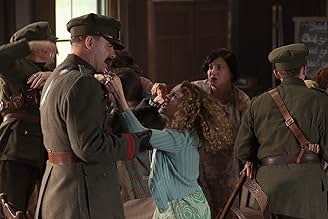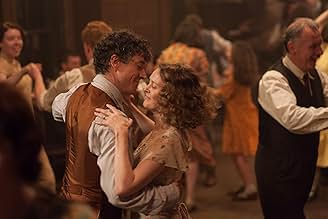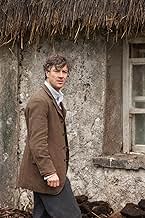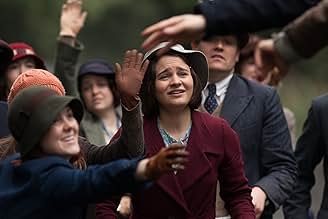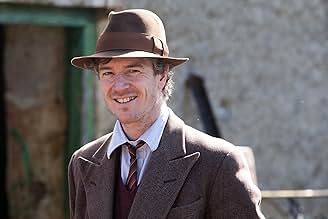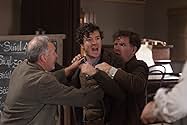Durante la Depressione, Jimmy Gralton torna a casa in Irlanda dopo dieci anni d'esilio in America e vedendo la povertà e l'oppressione, l'attivista che è in lui si risveglia e vuole riaprire... Leggi tuttoDurante la Depressione, Jimmy Gralton torna a casa in Irlanda dopo dieci anni d'esilio in America e vedendo la povertà e l'oppressione, l'attivista che è in lui si risveglia e vuole riaprire la sala da ballo che lo portò alla deportazione.Durante la Depressione, Jimmy Gralton torna a casa in Irlanda dopo dieci anni d'esilio in America e vedendo la povertà e l'oppressione, l'attivista che è in lui si risveglia e vuole riaprire la sala da ballo che lo portò alla deportazione.
- Premi
- 2 vittorie e 3 candidature totali
Recensioni in evidenza
All characters deliver solid to very good performances, the scenario is both subtle and not over- complicated, and the setting is enjoyable, as it offers a unique perspective on the 30's, seen from an agrarian Ireland.
It does have its weaknesses though. The movie starts with a good rhythm, a pace it sadly does not manage to keep. The last third of the movie feels needlessly slow and long.
Another problem is the way this movie seems to deliver a very subjective view of the opposition between the working class and politics.
Still very enjoyable and highly recommended.
As usual, the Catholic Church, the overlords and the unjust legal system come together to destroy any chance a small community has of the vital birth-right of culture and harmony for those who need it most; an isolated county in Ireland.
As one man steps up, after having been deported once already for the grand crime of opening a hall where people can learn such basic things as song, dance, art, literature and boxing, after his ten first ten year deportation, the local youth who have nothing to look forward to in life, convince him to do so again.
This is a straightforward movie about a circumstance that defies belief, and yet it occurred. Worth the watch for anyone who understands that oppression and fascism is wrong and that normal people deserve joy, community and to fight back when their world makes no sense on account of simply wanting to life a life.
Partially filmed in the village of Drumsna, a village only a few kilometers from Gralton's birthplace in Effrinagh, the film begins in 1932 with Jimmy's return to County Leitrim after having lived in New York for ten years. After showing historical footage of New York during the 1930s, particularly its poverty and unemployment during the great depression, we learn that Jimmy's brother has recently died and he is coming home to support his mother (Aileen Henry) in running the family farm. In a flashback to ten years ago, Jimmy is shown pleading with his then girlfriend Oonagh (Simone Kirby, "Season of the Witch") to go to New York with him, but she prefers to remain in Ireland. When he returns, he finds her married with two children, though they obviously still have feelings for each other.
When he responds "Same as ever" to her question about how he is, she tells him that "Nobody's the same after 10 years away." Now named after Patrick Pearse and James Connolly, two martyrs of the 1916 Easter uprising against British rule,Jimmy restores the boarded-up community hall that had been closed by the Catholic Church ten years earlier, stocking it with a wind-up Victrola and jazz records he brought from New York. Once again, the hall becomes a gathering place for workers and farmers and a thorn in the side of the Church. Dances are picketed and classes disrupted, but Jimmy refuses to bend. Fearful of stoking community activism, Father Sheridan (Jim Norton, "Extremely Loud and Incredibly Close") stirs up his congregation by playing the Communist card and by warning his flock about the debasement of the country's morals.
"What is this obsession with pleasure?!" he demands, and asks "Is it Christ, or is it Gralton?" Railing against "the Los Angelization of our culture," the fearful pastor says that the hall has become a place where "the sins of jazz music and the rhythms from darkest Africa with pelvic thrusts may poison the minds," and reads aloud the names of those who went to the hall the previous night. Fortunately for Gralton, neither Karl Marx nor Joseph Stalin could make it. Repercussions do not take long to occur. IRA activist Commander Dennis O'Keefe (Brian F. O'Byrne, "Queen and Country") is shown whipping his daughter because hers was one of the names read aloud, shots are fired into the hall during a dance, and the hall is set on fire and burned to the ground on Christmas Eve, 1932.
The best scenes in the film are Gralton's one-on-one conversations with Father Sheridan in which he reflects on the father's outward display of hatred towards those who are working towards the common good, defying Christ's message to love thy neighbor. While Sheridan is undoubtedly the villain, the intimate talks with Gralton ultimately make a dent in his intransigence and he tells his friends that Jimmy has more courage than any of them and should be treated with respect. Though his hint of transformation is aided by a young priest, Father Seamus (Andrew Scott), it is too little and too late to make a difference to Jimmy who is arrested and, deported to America where he will live out the rest of his life.
Jimmy's Hall, like all of Loach's work, has its heart in the right place. It is well acted and filled with enchanting Irish folk music and high spirits, yet in sacrificing subtlety and nuance to score political points, it fails to come alive with real passion. The film does have an important message that is relevant to us in the present day where the concentration of wealth in a small percentage of the population threatens our democratic heritage, yet the characters are more cuddly than fiery, more one-dimensional symbols than fully realized human beings. In spite of the timeliness of the subject matter, Jimmy's Hall does not stir the blood.
This film is naturally quite critical of the church's stranglehold on Irish life and policy. Jim Norton's role in portraying this is invaluable, after all who better to portray a controlling, traditionalist,angry priest than Bishop Brennan himself? Indeed, Jim's character in this film completely mirrors his character in Father Ted... but believe me, that is NOT a criticism.
While the movie may be slow-paced and seemingly dull at certain inter-sections, it's importance for history cannot be discounted. Not so long ago, it would have been sacrilege to watch this film due to it's unsubtle portrayal of the church's sometimes intrusive influence on Ireland, in fact some probably would still consider it to be so. It also deals with the rise of Fascism in Ireland in the early 20th century, something that is almost absent from cinema.
The movie deserves more credit and should have a larger influence than it appears to have. Give it a chance, some may call it propaganda... it's not. Give it a watch.
What, indeed, could be wrong with opening a dance hall and cultural center? Well in the thirties Ireland was recovering from years of bloody conflict, first the war for independence, followed by more years of civil war. Father Sheridan argues that now is the time for reconciliation, not for political agitation, and what he sees as communist propaganda. It is time for being Irish together, for listening to Irish music rather than "alien Jazz from deepest Africa".
Of course the Loach's sympathy (and ours) goes to the yearning of the young people who have no place to go, no prospects, no jobs, and who desperately want to find some joy, relief and self-expression. The movie may be a bit slow at times, but it is deeply moving.
Lo sapevi?
- QuizThe real Jimmy Gralton was the only Irishman ever deported from Ireland after Irish Independence. After the release of the film, a 2015 campaign (including an online petition) was started with the aim to rescind the deportation order and extend an official apology to his family. In 2016, this resulted in the President of Ireland stating the only deportation of an Irishman from Ireland was "wrong and indefensible." He unveiled a Gralton memorial at Effrinagh outside Carrick-on-Shannon, on the site where the hall once stood. The stone edifice, which tells Gralton's life story as a labor campaigner, was partially funded by the trade union movement.
- BlooperTobacco consumption (cigarettes, snuff and pipes) was extremely widespread at the time, yet none of the characters are seen to smoke, even at raucous social occasions.
- Citazioni
James Gralton: We need to take control of our lives again. Work for need, not for greed. And not just to survive like a dog, but to live. And to celebrate. And to dance, to sing, as free human beings.
- Curiosità sui creditiAt the end of a long list of people and organizations under the heading "Thank You" in the end credits, Dixie the horse, Cabundie the donkey, and Homer the three-legged dog are mentioned.
- ConnessioniFeatured in La noche de...: Jimmy's Hall (2017)
- Colonne sonoreSugar Foot Strut
Written by Harry Myers, Billie Pierce, Charles Schwab, Georges Matis
Used by kind permission of Carlin Music Corp.
Performed by Louis Armstrong & His Savoy Ballroom Five
courtesy of Sony Music Entertainment Inc.
I più visti
- How long is Jimmy's Hall?Powered by Alexa
Dettagli
- Data di uscita
- Paesi di origine
- Siti ufficiali
- Lingue
- Celebre anche come
- Jimmy's Hall
- Luoghi delle riprese
- Killanummery, Co. Leitrim, Irlanda(Jimmy's Hall and surroundings)
- Aziende produttrici
- Vedi altri crediti dell’azienda su IMDbPro
Botteghino
- Budget
- 6.911.962 € (previsto)
- Lordo Stati Uniti e Canada
- 560.592 USD
- Fine settimana di apertura Stati Uniti e Canada
- 19.881 USD
- 5 lug 2015
- Lordo in tutto il mondo
- 4.825.184 USD
- Tempo di esecuzione
- 1h 49min(109 min)
- Colore
- Mix di suoni
- Proporzioni
- 1.85 : 1



